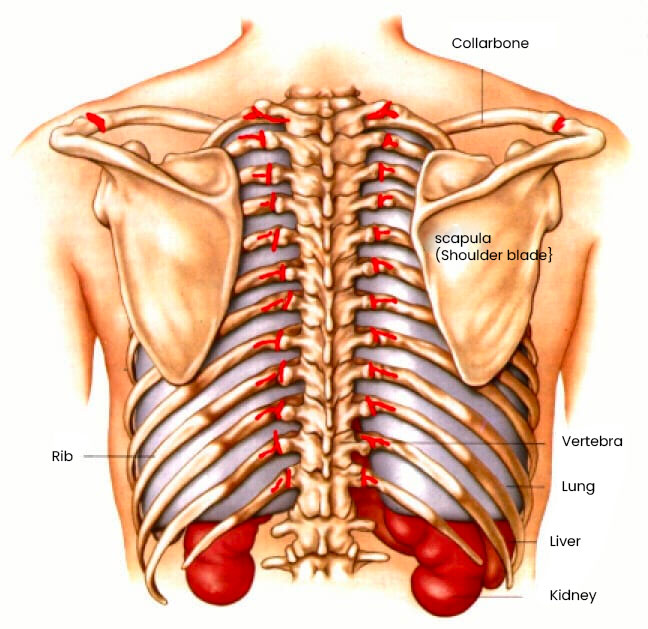
Back chest (red = pain zones)
Possible causes
The exact cause of the Tietze syndrome is unknown. But research over time has come up with some possible causes: actions such as very deep breathing, lying, bending, scraping of the throat, coughing, sneezing and heavy exertion. Other possible causes could be: Trauma, something like a punch to the ribcage. Unusual (if not heavy) physical exertion, pregnancy or an infection of the upper airways.
Identification of circumstances that causes Tietze and minimize re-occurrence
Try, in consultation with your GP, to find out the actions that could have contributed to the onset of Tietze in your situation, by, for example, a logbook. Try to clarify cause and effect; did Tietze result from stress or is stress the result of Tietze. Try to avoid activities that put a great stress on the ribcage, which may result in manifestations of Tietze.
Symptoms / Manifestations
- Most often a sharp pain in the chest area, especially when touching or applying pressure the ribs or the sternum.
- Swelling or redness does not always manifest, just the pain and local sensitivity. When there is swelling it will most likely be at the underside of the sternum and will color the skin red and is very painful when touched.
- The pain gets worse with exertion or movement which expands the ribcage and dislocates the ribs, like very deep breathing, lying, bending, scraping of the throat, coughing, sneezing.
- Radiating from pain to the ribs and spine can occur.
- Pain can start at different locations and can radiate to the arms.
- Nauseating feeling, stress and a gripping feeling of the chest area.
- The affected area is very sensitive when touched.
- Affection of cartilage on other than typical Tietze locations is possible.
- Feelings of fear; It’s not clear what the cause and effects are.
- Pain on the left side of chest seem to indicate to heart defects (heart attack) but this can be eliminated after a check-up.
- Negative influence to the functioning of the lungs, gullet, stomach and intestines seem to be caused by Tietze. This has not been thoroughly researched however.
- It is a pure local affection.
- Tietze most often occurs before 40, particularly during the teens and adolescence. Cases from very young patients are also known to occur.
- Tietze affects both men and women.
- In the most cases the disease will disappear completely after a while, in other cases it will stay.
Always consult a GP for further medical examinations, further information and testing






